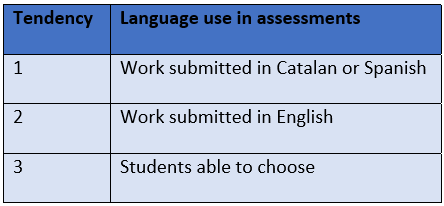An active methodology at the University of Girona from the EME Teaching Innovation Network

EME refers to the teaching of academic subjects through the medium of English in contexts where English is not the usual language of communication. It is not about teaching English, but about using it as a communicative tool to teach and learn academic content. Also known as EMI (English as a Medium of Instruction), the term EME has emerged for both linguistic and pedagogical reasons. Linguistically, it places particular emphasis on the multilingual nature of today’s university classrooms, in which students do not always share the same first language.
Pedagogically, it moves away from a conception of teaching as a unidirectional or merely instructional process and aims to foster active, learner-based methodologies.
English Medium Education in different subjects at the UdG
EME is used to a greater or lesser extent in most degree courses at the University. The EME Teaching Innovation Network has carried out a study on how its members apply EME in core and elective subjects in different departments of the University.
The study has provided interesting data on:
- Objectives of EME
- EME teachers
- EME students
- Learning objectives and outcomes
- Teacher role and methodology
- Assessment
- Impact & questions for further study
A brief summary of the data is presented below. More detailed information will be provided in the Handbook for EME Teachers at the following link: http://hdl.handle.net/10256/23741.
Objectives of EME
- Objectives are closely linked to the internationalisation of higher education
- EME can contribute to the development of students’ international and intercultural competences
- EME can increase access to international and intercultural learning and make it more inclusive (without the need to go abroad)
- EME can generate insecurity and/or resistance if not accompanied by transparent and coherent objectives and rationales
EME teachers
EME requires additional effort which can have a positive impact on teachers’ professional competences:
- Capacity to present a topic succinctly
- Capacity to interact and communicate with students
There is no minimum language level stipulated to be able to deliver EME classes, but teachers who have obtained the Teaching in English Certificate for Teaching and Research Staff (Modern Language Service) report that it has helped them feel more confident while teaching in English. Language shifts often provoke reflections among teachers about their own linguistic and professional roles and identities.
EME students
There is a marked difference between students who choose an optional subject in English and students enrolled on a compulsory subject taught in English. In the second case, there may be a considerable variety of language competence levels. Students with lower language levels need measures and strategies in place so that they are not unfairly disadvantaged by the language of instruction and are able to follow the subject. Language switching can have a significant effect not only on students’ performance, but also on their identity. For this reason, it is particularly important to create a learning environment that nurtures and protects each individual’s identity and encourages their participation and involvement in the classroom.
With regard to the use of English to teach a subject, a correlation has been found between a clear/shared sense of purpose and student/teacher satisfaction. Including activities to reflect on the subject can help create a joint sense of purpose and minimise any difficulties that may arise. For example:

Learning objectives and outcomes
The change of language often generates doubts about the focus of lessons: should the focus be on learning content or on understanding and/or improving the language? EME teaching staff tend to perceive themselves as content experts rather than language teachers. However, strategies to support language learning can make it easier for students to understand and follow the subject. The learning objectives of a subject should not vary according to the language of instruction. If learning outcomes are negatively affected by the language used, different options need to be considered:
- Is EME viable/appropriate in all contexts?
Rigorous debate is needed in each specific context, taking into account the programme of study.
- Are all learning outcomes being assessed?
- Are the transversal competences developed in the subject being taken into account (e.g., interpersonal and interactional skills, active participation, autonomy)?
An approach that takes into account transversal competences will help create an interactive and student-centred climate which, in turn, will facilitate content learning and understanding.
Teacher role and methodology
A shift in focus regarding learning objectives often generates important reflections on the role of the teacher. Creating an active and participatory classroom climate means maximising student speaking time and, consequently, reducing teacher speaking time. In addition to delivering the necessary content, EME teachers provide constant support and guidance to facilitate students’ learning and development.
Assuming the role of guide or facilitator means reducing time spent in lecture mode and introducing active methodologies that stimulate interaction between students and active learning. Some of the methodologies promoted by the other ICE Teaching Innovation Networks are particularly appropriate, including Cooperative Learning, Flipped Classroom and Problem-Based Learning, among others. A class taught in a foreign language entails greater cognitive demands. Frequent changes of pace and the use of varied activities with effective visual aids can help maintain student concentration and participation.
Assessment
Assessment is the issue which generates most concern among students enrolled on EME subjects. As mentioned earlier, students with lower language levels need measures and strategies in place to ensure that they are not unfairly disadvantaged by the language of instruction. A variety of assessment methods should be used to provide students with different opportunities to demonstrate the knowledge they have acquired and the competences they have developed. Self- and peer-assessment activities can foster greater learner autonomy and fit well with the active methodologies mentioned above. More detailed information on the use of these strategies is provided by the Teaching Innovation Network on Assessment Strategies.
Regarding language requirements in assessment activities, clear criteria must be established in accordance with the learning objectives. The study carried out by the EME Teaching Innovation Network identifies three trends in the different modules taught by the members of the network:

The decision to opt for one or the other seems to be closely correlated with whether the subject is optional or compulsory, together with other factors discussed in greater depth in the Handbook.
Impacts
The change of language of instruction may have an impact on the quality of studies and on student satisfaction levels. Constant monitoring is important to ensure that the impact is positive. It is therefore highly recommended to include the voices and perspectives of students in consultation processes to decide whether EME is appropriate in each context and how it can be implemented in the most effective way.
It is often suggested that the use of EME has a positive effect on students’ future prospects, improving their job opportunities and developing their global competences. The EME Teaching Innovation Network plans to carry out further research to test this hypothesis and assess the real impact on learners.
There is a broad consensus among the members of the EME Teaching Innovation Network that becoming an EME teacher has had a positive effect on their professional life, generating new opportunities and experiences that have impacted positively on their overall teaching practice. The EME Teaching Innovation Network intends to conduct further research on this aspect to identify the benefits and challenges of becoming an EME teacher, thereby stimulating reflection and continuous improvement in this area.
Recommended citation:
Waddington, J. (2023): English Medium Education (EME). An active methodology at the University of Girona from the EME Teaching Innovation Network. ICEberg UdG. https://iceberg.udg.edu/?page_id=15840

References
English Medium Education. A literature review
Galloway, N. (Ed.). (2020). English in higher education – English medium. Part 1: Literature review. London: British Council. https://www.teachingenglish.org.uk/sites/teacheng/files/L020_English_HE_lit_review_FINAL.pdf
Scientific articles highlighting critical issues in EME & EMI
Dafouz, E. & Gray, J. (2022). Rethinking the roles of ELT in English-medium education in multilingual university settings: an introduction. ELT Journal. https://doi.org/10.1093/elt/ccab096
Macaro, E. (2015). English Medium Instruction: Time to start asking some difficult questions. Modern English Teacher, Vol 24/2: 4-7. https://www.modernenglishteacher.com/media/5377/macaro.pdf
